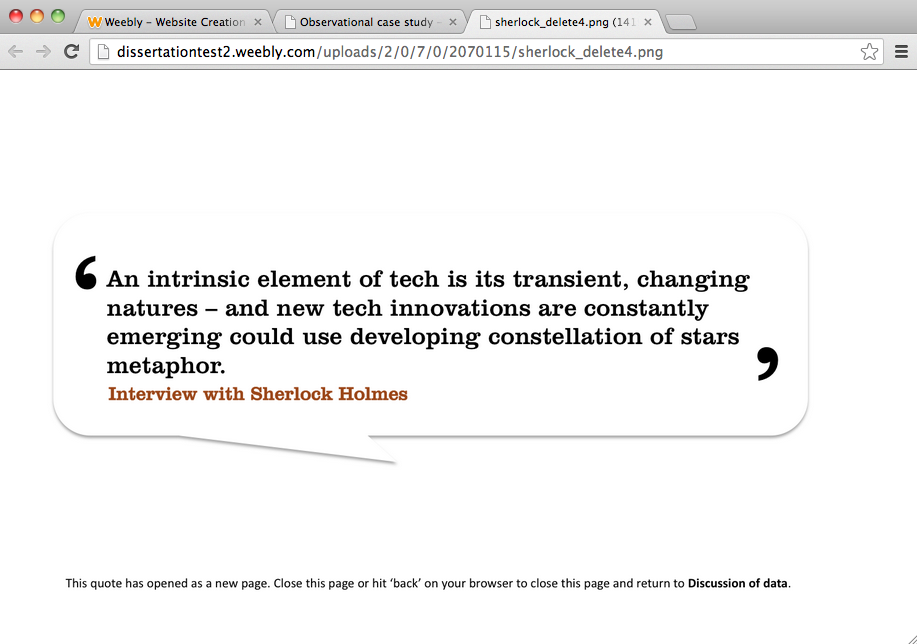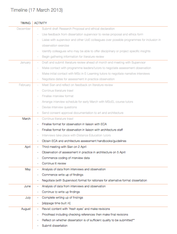|
Having revisited and then categorised the data from the seven interviews, I've rewritten the my original research questions (submitted within my 17 December Research Proposal). On reflection, questions 2 and 3 from my Research Proposal cover too much of the same ground. Also, the questions ignore the conditions that promote/discourage multimodal approaches to assignments, which has been one of more interesting themes to emerge from both the data and my lit review. I think the new combination of questions are also more able to directly address my overarching question posed within the dissertation. Anyway, I have gone... From this:
...to this:
0 Comments
Is there a way that, within my text, I can regularly hyperlink to quotes from the data?
This would be in addition to having key quotes reprinted in full. At least, I think it would. Or maybe that wouldn't be necessary. Maybe it would look a bit odd to have both. This might work by having linked text which, when clicked would open up a cut out diagram of the relevant quote, perhaps highlighted as itching a slightly larger part of the transcript, with the other text in faded grey. Ideally, a hover over would work better but I don't think that's possible from a text section in weebly. Maybe though the words could link to images - in a new page - at are themselves uploaded as documents. It'll be worth exploring this as its a more interesting way of presenting the research data and also better exploits the potential of hyperlinks. Actually, if this works, it would make sense to take the same approach when linking to relevant content within my blog (within the rationale section). So rather than linking to the whole blog post (where I would have to highlight the relevant text and tidy up/check what's around it) it would instead link to a cut out. In fact maybe I don't use actual cut outs but instead reproduce the text as if it has been lifted from the blog or transcript, allowing for accompanying biographical or background information as required. This could the date and title of the blog entry from which the text is drawn, and for the interview data. This should probably go in the discussion and analysis of data section.
I'll obviously link to the two artefacts (maybe from representatives image rather than just a text hyperlink) but alongside that I will need to offer a bit of background to the two artefacts, including in which ways they might be viewed a multimodal, how they differ, why I chose them, some very brief detail on the nature of the stipulated assessment exercise, the course they were a part of, what the assessment criteria was for the exercise. Rather than being at the start of the section, this would be part way through. Amongst other things it would be a nice way of breaking up that section (which will be text heavy). Also, it wouldn't sit well directly after the detail outlining the nature of the DE course that will at the beginning of this section. Is it worth taking the thinglink approach here, using the literature to highlight the different modes. Perhaps I would take a screen shot of each assignment with the overlaying information (thereby allowing for sound, through the volume icon). Rather than taking an entirely discursive approach, my discussion of results will be broken and presented under different, clearly signposted themes. These would be based around the questions I asked and any other emergent themes.
This will be make for a better reader experience - the inclusion of signposts and also having shorter sections rather than a wall of text. It might also aid the structure and make the writing process more straightforward. This will require me to have a clear structure in my head before putting the thing on paper/screen. On holiday and currently without access to the interview transcripts (or at least, a desire to look through them whilst on holiday and with only small bits of time here and there for study). This is potentially a useful exercise, though: reflecting from memory on what the key themes are to have emerged from the data. Perhaps being apart for the transcripts will help me to identify the most significant themes. Here goes, then:
Actually, I think this has been an interesting exercise. It's interesting that so many ideas stand out considering it's a little while since I looked at the transcripts. Why should my discussion of the data be purely text-based (as I've had in my head). It should be multimodal. And this goes beyond a the use of enlarged type and so on as purely aesthetic visual effects. It should by critical. Here's an idea, then:
While this has been a useful bit of quick thinking-and-jotting-down, I suspect that I should probably focus on the data and see what types of visual approaches lend themselves to emerging themes, rather than thinking of visual approaches and then trying to find data to match.
Jen themes:
Sian themes:
Marshall themes:
Christine themes:
Rory themes:
Clara themes:
Hamish themes:
Where tutors have experience multimodal assessment as a student, this has influenced their attitude towards multimodality as a tutor. And this includes digital and pre-digital multimodality. This links into another idea expressed by some within interview that tutors can usefully reorient themselves by completing multimodal assessment themselves.
Just an idea, but maybe I can be a bit more imaginative that simply displaying a direct quotation as a text. Maybe I could take a cut out of the screen shot and paste it in as an image? Or maybe I could do something like this: If I do go with this idea, I could similarly use it for indented direct citations within the literature or citing course documentation. Actually, that could be a bit like overkill and would reduce the sense of voice projected by these quotes. Maybe it works better when it has been someone's spoken words.
I wasn't sure about this when I started typing, however I quite like it now as it does bring key bits of data - and they have to be key in order to be reproduced directly - to the fore. Also, there are some really fantastic lines in the data that merit being foregrounded like this. The font if Clarendon BT, the same as for the title on the front cover. Does it appear more book-ish than conversation? It's a nice clear font though. Maybe this would work for quotations for text as well, but perhaps without sing versus double punctuation marks. I like this. Can I use the interview data to inform my dissemination rationale? It would seem crazy and artificial not to.
For instance, if I know what markers might see as strengths/weaknesses within a multimodal format piece of work, how can I ignore this (particularly when some of the same individuals will be marking my work)? In fact, perhaps I go a step a further and include the data in an up-front way. For instance, maybe I will say in discussion how the interviews gave me insights into multimodal assessment that inevitably informed my work. I could present the interviews as offering some of the same value that would come from student-tutor dialogue that was referred to in a couple of the interviews. This would be interweaved with the relevant literature. Is there a danger of overdoing the literature? I could also make reference to my own blog. How would this look? Perhaps under different topics I would have a relevant direct quote from the data before discussion of how this relates to the literature, assessment criteria and my own experiences, perhaps taking sections from my blog. And perhaps the different sections would in turn be taken from text drawn directly from the assessment criteria. So, the rationale would a combination of: - different points taken from course dissertation guide that form the structure - direct quotes from the data, as well as indirect citation for each of the key point - brief relevance to the relevant parts of the literature - reflection on how this has influenced my work, perhaps with text taken from my blog Actually, this ends up being a mixture of personal and critical reflection, with interweaved with the assessment criteria and interview data. Step 0: Background preparation
Step 1: Saving and reading
Step 2: Reflecting on emergent themes in relation to research questions and literature
Step 3a: Synthesis
If I manage all this, I'll have had a really effective week, dependent on the quality of the emergent themes. Next week I'll try and draw some conclusions. |
Categories
All
Archives
October 2013
TimelineOther stuff
|


